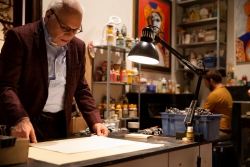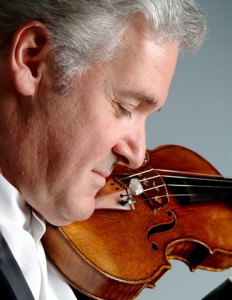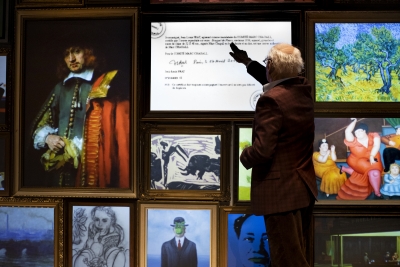 |
True Copy in the 2023 Hong Kong Arts Festival left a long-lasting aftertaste on me. The show was conceived and produced by BERLIN, a theatre company that creates work through documentary and interdisciplinary approaches. What makes an artwork genuine? The main question posed towards the audience is equally applicable to their show. A week after the viewing, the question still lingered in my mind without a definite answer. True Copy is an ingenious and entertaining critique of theatre as a performing art through the dramatized "true" story of Geert Jan Jansen, a painting art forger.
The show is an account of Jansen’s redemption story in two parts. In the first part, he chronologically recollected the significant events in his adventurous career, ending with his arrest in 1994. In the second part, the narrative jumped to his well-intended mischievous project with BERLIN in 2018 to "recovery" Tete d'Arlequin, the lost Picasso painting amid the Dutch museum heists by Romanians in 2012. These two parts intertwined and formed the plot of the show. At the end of the story, Jansen proclaimed that he had grown and found joy in creating his original painting.
On retrospective inspection, Jansen's playful and humorous retelling of his autobiographical story appeared credible. After all, given his shady past, the audience would be wary of his anecdote and view him as an unreliable narrator. Throughout the show, I doubted his story and engaged in a game of identifying his lies. Rationally, I did not treat his absurd illustrations in a deadpan manner as lies since they were clearly for comedic effect. For instance, he alleged that he aged the forged painting by stepping on it or placing it in the dirt and he forged the signature before drawing. Despite making the audience laughs, these jokes mock what experts relied on identifying genuine painting. Unable to catch him red-headed in the show, I verified his stories by fact-checking online afterwards. To my surprise, his story is accurate on a broad stroke with minor discrepancies in the details. One example of those discrepancies was his real arrest in 1994 resulted in his one-year imprisonment. Instead, in the show, Jansen alleged that he had not been prosecuted because victims and experts, out of self-interest, were unwilling to testify. Although BERLIN and Jansen had taken some creative liberties, I still opine the show is a true copy of Jansen's story.
It is shocking for me to find out that their fake recovery of Tete d'Arlequin did happen in our reality. This unlikely prank was confirmed and reported by multiple media outlets. During the show, I presumed that the incident was an invented story aiming to blur the distinction between true and false, the show’s motif. Besides, having been accustomed to Jansen's exaggerated tales as jokes, it is only logical to also perceive this ludicrous project as a satire. Little did I know, BERLIN and Jansen were bold and mad enough to play out their planned script in the real world, outside of the theatre. It can be said that the true drama of this production happened before the first show even began. What was re-enacted in the show is merely a mimic of the original act in our real world. This not only makes perfect sense from the story theme perspective but also points out that the nature of traditional theatre is merely capable of producing copies of the real drama.
BERLIN has chosen a suitable performance format for a television news magazine that provides in-depth coverage of a topic to convince the audience that what happens on stage is live and real. The performance started without the convention of house call and the darkening of the lights. Furthermore, the technician crew sat clearly visible in front of the audience. There was no fourth wall dividing the stage and the audience. Together they were as if situated in a television production studio. Following the television programme tropes, the host briefly introduced classical painting first and then proceeded to interview his guest, Jansen, about his art forgery profession. The piece adopts various techniques commonly used in documentaries to engage the audience, for instance, exhibiting documents, showing archive videos, and staging "live" demonstrations. Apart from Jansen going behind the set to demonstrate art forging through ‘live camera’, BERLIN hid nothing away from the audience. The audience was almost convinced that the show was entirely live and real.
It is the gorgeous technological set and the calculated live video that planted the seed of doubt about BERLIN’s created reality. I mistook the wall of paintings with different sizes as real-world objects before the video playback in a painting frame broke the illusion. The set design of replacing real canvas with screens is a beautiful contemporary design commenting our digital screen, showing a copy of reality, had dominated our city life. However, I opine that the illusion was dispelled too soon and the show would have benefitted from a more gradual lifting of the façade. There is a lost potential for dealing with the topic of digital copy and forge copy. Regarded the live videos, there is an artificial and unnatural texture to them. Firstly, watching a video played in a painting frame is unusual in itself. Watching a video of a painting being forged within a painting is just bizarre. Secondly, although shaky camera movements were applied when Jansen went into his rooms behind the stage, the mise-en-scene was too well-lit and arranged. The live-camera video feed of a mobile phone had no tiny flaws, such as being out of focus and choppy. These contradictions and unnaturalness put me in a critical mindset, especially when watching the ‘live camera’ session. I felt the videos were a bit too long and I had already figured out that the live ones were previously recorded. Hence, I was not surprised when the set was opened to reveal its empty interior.
The revelation that Jansen was portrayed by an actor is a powerful twist that coheres with the theme of the show. The audience gasped and was taken by surprise when Yves Degryse removed the highly realistic mask of Jansen’s Face in a ‘Mission Impossible' style. The real Jansen only appeared in the video while Degryse did a terrific job imitating the art forger’s speaking manner, posture, gait, etc. Degryse’s acting is composed, natural and believable. The unmasking correlates back to Jansen’s line saying that art forgers were only credited when they were caught. Should Degryse have not removed the mask, the audience would not have credited his performance, especially when the names of the performers were not listed in the brochure. The timing of the unmasking in the final minute of the show was excellent in challenging the audience’s personal stance and belief in art forging when theatre, a similar art practice, was brought into the picture. This is the reason my contemplation lingered long after the show.
Lastly, I would like to write a few words for the auction scene. In the performance I attended, the Hong Kong audience happily went on a bidding war for the forged painting as if it was just a game without no consequences. I speculate the scene was intended for the audience to self-reflect on the personal value of the counterfeit painting by comparing it with the value of others. Indeed, an audience with different cultures and personalities would have affected the dynamics of the interactive scene in various ways. A simple inclusion of the local regulations and a brief mention of the payment procedure may be sufficient to persuade the audience to treat the scene seriously resulting in an improved overall experience.
All in all, True Copy is a sophisticated theatre piece that blended entertainment and intellectual debate wonderfully together.
本網站內一切內容之版權均屬國際演藝評論家協會(香港分會)及原作者所有,未經本會及/或原作者書面同意,不得轉載。










